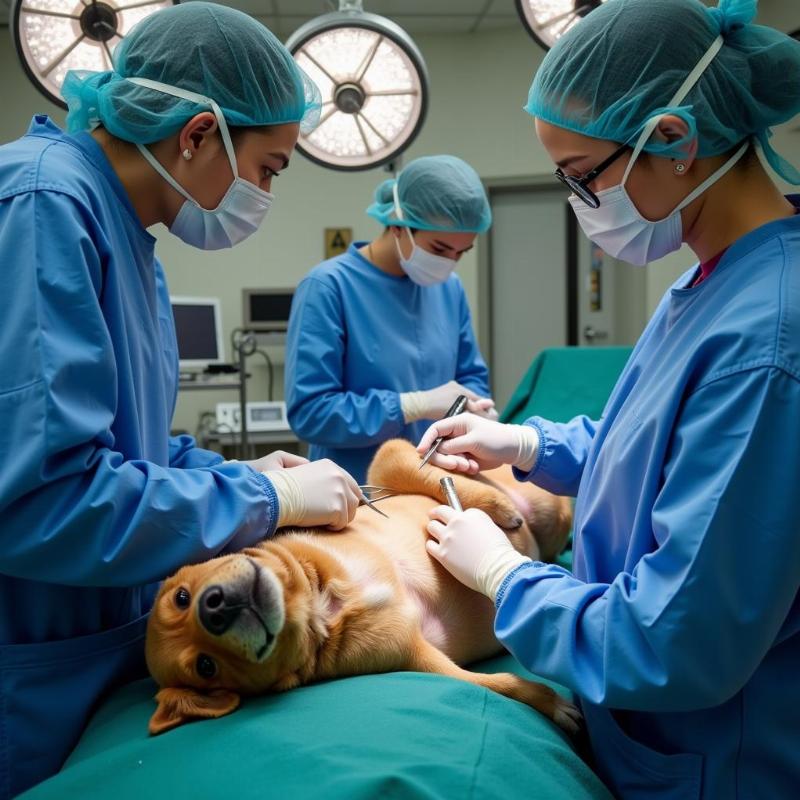Spaying your dog, also known as an ovariohysterectomy, is a common surgical procedure that removes the ovaries and uterus, preventing pregnancy and eliminating heat cycles. Determining the optimal timing for this procedure is crucial for minimizing health risks and ensuring a smooth recovery. Many owners wonder, “How soon after heat can a dog be spayed?” While it’s possible to spay a dog during any point in her cycle, the timing can significantly impact the complexity of the surgery and potential complications. Let’s delve into the details and explore the best approach to spaying your furry companion.
Understanding Your Dog’s Heat Cycle and Spaying Timeline
A dog’s heat cycle, also known as estrus, is a complex hormonal process that typically occurs twice a year, although this can vary depending on breed and individual dog. Understanding this cycle is key to making informed decisions about spaying. The cycle is generally divided into four stages: proestrus, estrus, diestrus, and anestrus. Spaying during proestrus or estrus, when bleeding is present, can lead to increased bleeding during the surgery. This can make the procedure more complex and potentially increase the risk of complications.
Traditionally, veterinarians recommended spaying before the first heat cycle. However, recent research suggests that the optimal timing may vary depending on breed and size. For smaller breeds, spaying before the first heat remains a common recommendation. However, for larger breeds, delaying spaying until after puberty, or even after the first heat cycle, may be beneficial in reducing the risk of certain orthopedic and cancerous conditions.
 Spaying a Dog After Her Heat Cycle
Spaying a Dog After Her Heat Cycle
Spaying Immediately After Heat: Risks and Benefits
Spaying immediately after a heat cycle is technically possible, but it’s generally not the preferred timing. The uterus is engorged with blood during and immediately following a heat cycle, which can increase the risk of bleeding during surgery. This can complicate the procedure and potentially prolong the recovery period. However, if your dog has an unexpected pregnancy scare after her heat, spaying may be a necessary option.
While the increased risk of bleeding is a concern, some veterinarians may choose to spay a dog shortly after her heat if specific circumstances warrant it. For instance, if there are concerns about unwanted pregnancies or the owner is unable to schedule the surgery at a later date. In such cases, your veterinarian will take extra precautions to manage bleeding and ensure a safe procedure.
The Ideal Time to Spay: Waiting Between Cycles (Anestrus)
Most veterinarians recommend spaying your dog during anestrus, the period of reproductive rest between heat cycles. This period typically lasts for several months and provides the most stable hormonal environment for surgery. Spaying during anestrus minimizes the risk of bleeding complications and allows for a smoother, faster recovery.
During anestrus, the blood vessels in the reproductive tract are less engorged, making the surgery less complex and reducing the risk of excessive bleeding. This also translates to a shorter and less painful recovery for your dog. Your veterinarian can help you determine the best time to spay your dog based on her individual heat cycle and overall health.
Consulting with Your Veterinarian is Key
While online resources can provide valuable information, it’s crucial to consult with your veterinarian to determine the best time to spay your dog. They will consider your dog’s breed, age, size, health history, and individual circumstances to provide personalized advice. Your veterinarian can also discuss the potential risks and benefits of spaying at different stages of your dog’s heat cycle and help you make an informed decision.
Remember, open communication with your veterinarian is vital for ensuring your dog’s health and well-being. They can answer all your questions, address any concerns you may have, and provide guidance throughout the entire process.
Conclusion
Spaying your dog is a significant decision with both health and behavioral implications. While the question of “how soon after heat can a dog be spayed” has a technically feasible answer, the ideal timing is typically during anestrus, the period between heat cycles. This minimizes surgical risks and promotes a smoother recovery. Ultimately, the best approach is to discuss your dog’s specific needs with your veterinarian, who can provide tailored recommendations for optimal timing based on her breed, age, and overall health.
FAQ
- How long does a dog’s heat cycle last? Typically, a heat cycle lasts for 2-4 weeks, although this can vary.
- Can a dog get pregnant immediately after her heat? No, a dog is not fertile immediately after her heat. The fertile period occurs during estrus.
- What are the benefits of spaying my dog? Spaying prevents unwanted pregnancies, eliminates heat cycles, and reduces the risk of certain cancers and infections.
- Is spaying a painful procedure? Dogs are under general anesthesia during the surgery and receive pain medication afterwards to manage discomfort.
- How long does it take for a dog to recover from spaying? Most dogs recover fully within two weeks, but individual recovery times may vary.
- What are the signs of a dog in heat? Signs include swelling of the vulva, bloody discharge, increased urination, and attracting male dogs.
- How can I manage my dog’s behavior during her heat? Keep her confined, use dog diapers, and avoid dog parks or areas with male dogs.
Beautdogs.us is your premier source for expert advice on dog breeds, care, and products. We are passionate about providing dog owners with reliable and comprehensive information to ensure their furry companions live happy, healthy lives. Whether you are a new dog owner or a seasoned expert, Beautdogs.us is here to support you every step of the way. Contact us for personalized advice and discover a world of resources dedicated to your dog’s well-being. Email: [email protected], Phone: +1 501-555-7529. Connect with Beautdogs.us today!